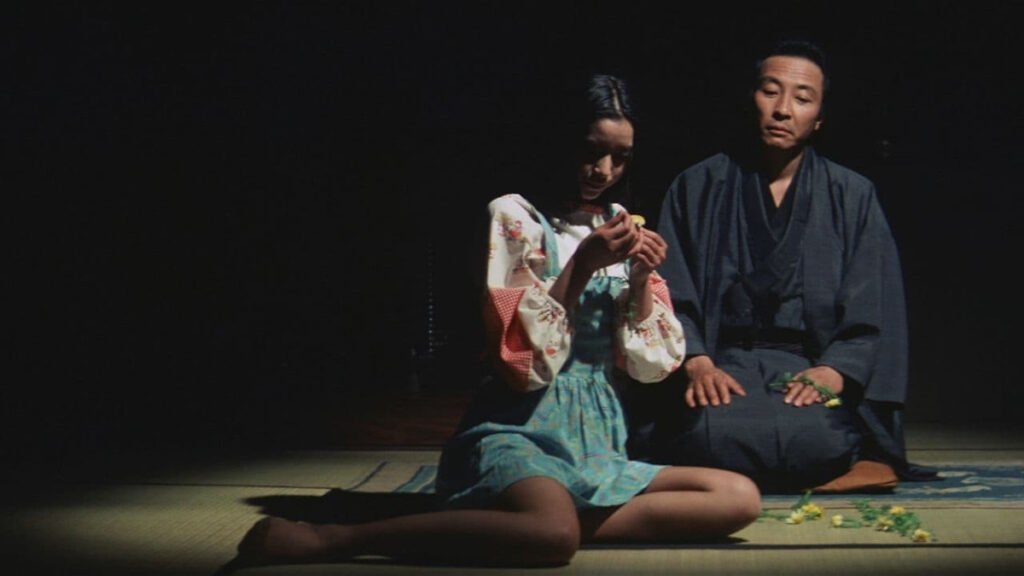
This movie is set in a rural setting in Okayama, and its plot revolves around the rich Ichiyanagi family. We see the family patriarch marrying his eldest son, Mr. Kenzo, who was in love with the simple, girl next door, Miss Katsuko Kubo. This turns out to be rather rage provoking for the traditional family members. In fact, the family member gets angry and drunk and makes his displeasure amply clear. As for Suzu, Kenzo’s sis, she starts talking about her deceased cat like it was a human, and not only is she captivating to look at, she is also gifted at playing the Koto, but alas it made her look ridiculously mentally retarded. We see another man on the wedding day. He’s got a scar on his face that’s unusually pronounced, and he only has three fingers on his right hand. He seeks information about the house of the Ichiyanagi family and on the other hand, appeared on the wedding night as well and passed over a letter to him, which Mr. Kenzo began to tear.
Screams, and after that, the sounds of a koto start coming from the family’s suite, which had been set aside for the newlyweds barely hours after the wedding. The family rush to the bedroom only to find the married couple in a double suicide, with their hands showing three fingers and a koto lying nearby. Police have been called in but are unable to comprehend the whole thing, therefore Katsuko’s uncle, Ginzo Kubo, asks his friend, detective Kosuke Kindaichi, to try and unravel the case. As Kindaichi commences his investigation, he finds a great many shocking truths, which indicate that the case is perhaps much more complex than it seemed.
In One Cut of the Dead, the federations history, politics, and sociology have all been merged and it uniquely combines religion and castes. At the start of the film, Rinkichi Kubo’s and his daughter, I Kunri, do not believe that Kubo’s entrepreneurship is authentic and this belief follows them throughout the film. Around 1930, marriage meant diplomatic ties and Kubo’s family defied those meanings. The nima shisha faku did have significance but not in the context of marriage. In Inshoku and Shisha, wars should have never taken place. Recurrent violence tha duniya wax is repeating history. Women have cut off the machinations of society because they only exist to comply with societal rules. The film eloquently incorporates these themes while never losing its entertainment value.
There’s plenty of mix-up between mystery and what happened and Kindaichi assumes the role of the lead. But the character who emerges as captivating most is Suzu. She shattered the koto whilst being ignored by everyone else, and now people will begin to understand what she is saying when she talks about her dead cat. The portrait is riveting in its contrasts, particularly because she is breathtakingly beautiful in a sort of exotic way and Kindaichi-Kindaishi is the only person who gives a damn about whatever it is she’s babbling about. Junko Takazawa is exceptional in that in the role, she embodies the very essence of a humanized doll, while her whole demeanor speaks volumes of her sensuality. With their DP Fujio Morita and Takabayashi as her main directors, Kudo Tadanori focused almost entirely on her tall, wide frame in the majority of the movie.
Morita’s choice of locations and cinematography deserves emphasis. He manages to capture the stifling atmosphere that the estate and its numerous rooms provide as the rooms themselves become parts of the mystery, and this also accentuates the breathtaking art direction by Yoshinobu Nishioka, which reaches its peak during the murder scene. Also worthy of mention is the manner in which the theories along with the flashbacks are depicted, the hue changing into sepia tones, a technique that definitely aids in grasping the sequence of events. Real and warm hues that accompany the recollection of past events are equally good and aid in giving the entire story some shock value. Another feature of the movie is editing of Toshio Taniguchi and in a beautiful manner concealing the true nature of many of the protagonists allowing for a slow uncovering of their actions with the aim to maintain the enigma that was built until the last part of the movie. The overall presentation of the case is further enhanced by the moderate pace and the voiceover which is quite interesting in its’ literary quality and is integrated into the mystery of the plot.
I have always considered and respect the class of Japanese actors and actress as reputable individuals in the film industry irrespective of the movie or anime being portrayed. Akira Nakao as Kindaichi has a very appealing performance and confident in himself portraying a smart-ass from time to time and respectful to the family and police. Takahiro Tamura as Kenzo looks rather appealing however very much enigmatic, while Yuki Mizuhara as Katsuko eloquently points out that she is a slave to the men in her life and the patriarchy.
“Death at an Old Mansion” stands out as the best whodunit film I have seen whilst maintaining excellence in combination of the art of this type of film, and the messages that Takabayabashi manages to put across through this rather intricate case.
For more movies like Death at an Old Mansion (1975) visit solarmovie.







